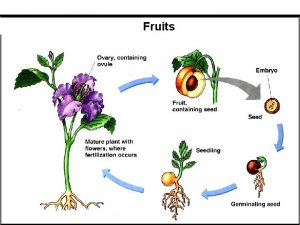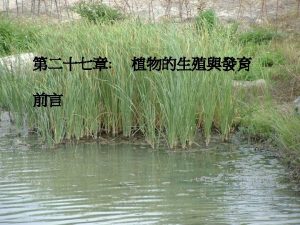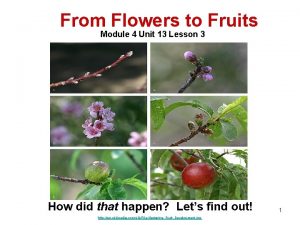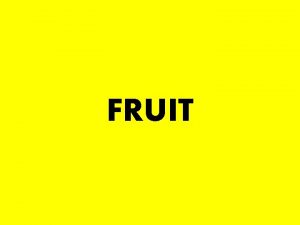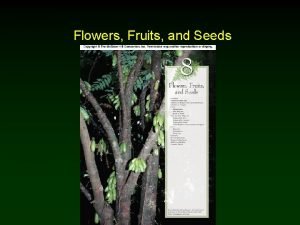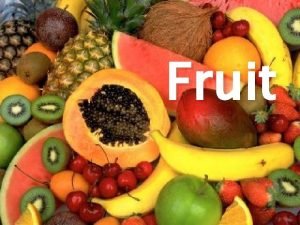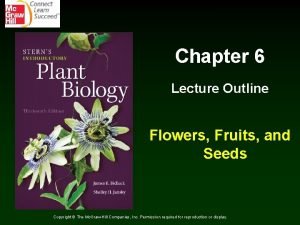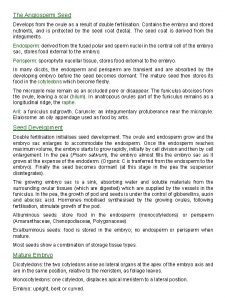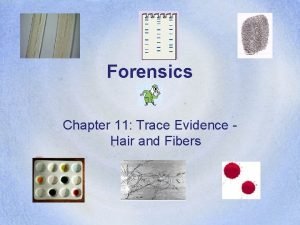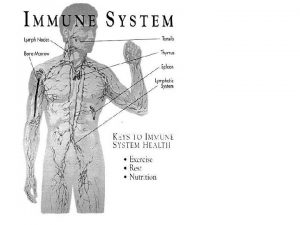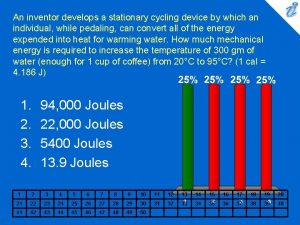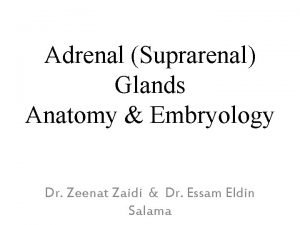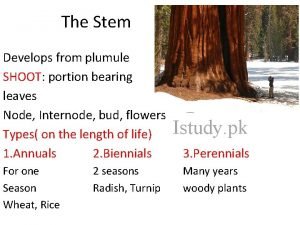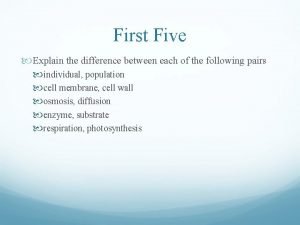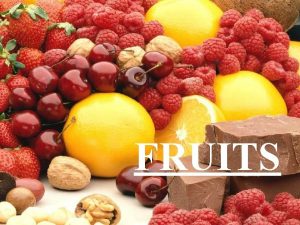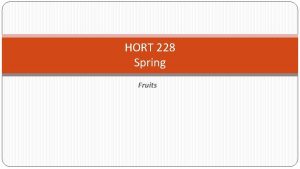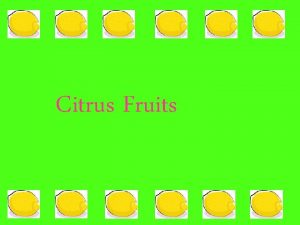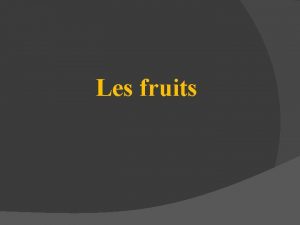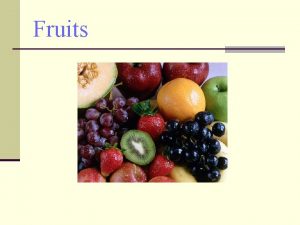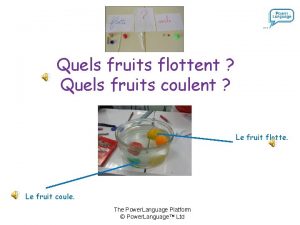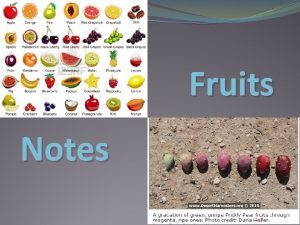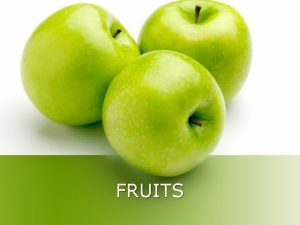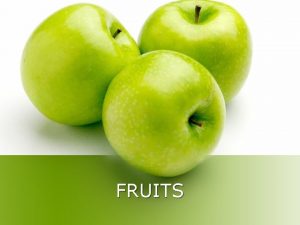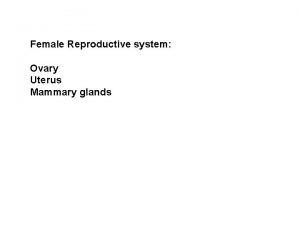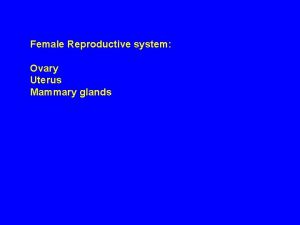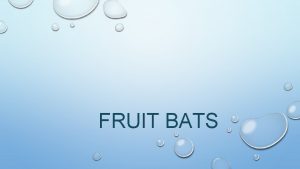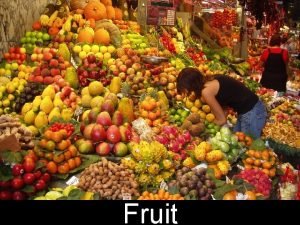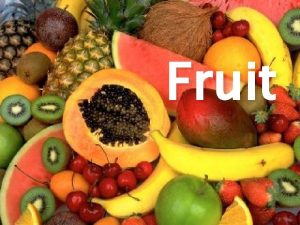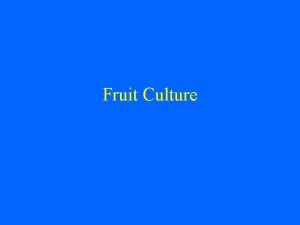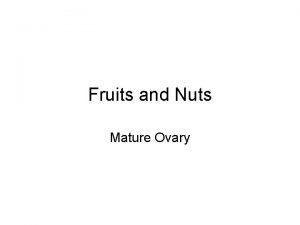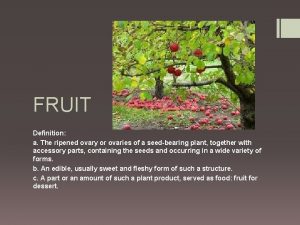Fruits A fruit develops from the ovary wall





























- Slides: 29

Fruits

A fruit develops from the ovary wall after fertilization of the egg in the ovule A seed develops from the ovule after fertilization of the egg in the ovule


The mature fruit (pericarp) can be analyzed on the basis of the characteristics of three subdivisions Exocarp = outermost Mesocarp = middle Endocarp = innermost

I. Simple Fruits: A single ripened ovary from a single flower. A. Fleshy Fruits: Most of the ovary wall (pericarp) is soft or fleshy at maturity. 1. Berry: Entire pericarp is fleshy, although skin is sometimes tough; may be one or many seeded. E. g. grape, tomato, papaya, pomegranate, persimmon, guava, banana and avocado.

2. Pepo: Berry with a hard, thick rind; typical fruit of the gourd family (Cucurbitaceae). E. g. watermelon, cucumber, squash, cantelope and pumpkin.

3. Hesperidium: Berry with a leathery rind and parchment-like partitions between sections; typical fruit of the citrus family (Rutaceae). E. g. orange, lemon, grapefruit, tangelo and kumquat.

4. Drupe: Fleshy fruit with hard inner layer (endocarp or stone) surrounding the seed. E. g. peach, plum, nectarine, apricot, cherry, olive, mango and almond. Some botanists also include the fruits of walnuts, pecans, date palms, macadamia nuts, pistachio nuts, tung oil and kukui nuts as drupes because of their outer, green, fleshy husk and stony, seed-bearing endocarp. These latter fruits are also called drupaceous nuts.

5. Pome: Ovary or core surrounded by edible, fleshy receptacle tissue (hypanthium or fleshy floral tube) that is really not part of the pericarp. The actual ovary or core is usually not eaten, at least by most humans. This is typical fruit of certain members of the rose family (Rosaceae), including apple, pear, quince and loquat.

B. Dry Fruits: Pericarp dry at maturity. 1. Dehiscent Dry Fruits: Pericarp splits open along definite seams. a. Legume: An elongate "bean pod" splitting along two seams; typical fruit of the third largest plant family, the legume family (Leguminosae or Fabaceae). The pod represents one folded modified leaf or carpel that is fused along the edges.


b. Silique: A slender, dry, dehiscent fruit that superficially resemble a legume, except the mustard silique is composed of two carpels with a partition or septum down the center (i. e. between the two carpels or valves). This is the typical fruit of the mustard family (Cruciferae or Brassicaceae). E. g. field mustard, turnip and cabbage (Brassica species).

c. Capsule: Seed pod splits open is various ways and usually along several definite seams. Capsules typically split open into well-defined sections or carpels which represent modified leaves. This is a very common dry fruit found in many different plant families. E. g. Catalpa, Jacaranda, Pittosporum, Aesculus, Agave, Yucca, Eucalyptus, devil's claw (Proboscidea), floss silk tree (Chorisia), kapok tree (Ceiba) and castor bean (Ricinus communis). Capsules may split open along the locules (loculicidal), along the septa (septicidal), through pores (poricidal), or the entire top of the capsule separates as a single lid-like section (circumscissile). A common landscaping tree in southern California called the golden-rain tree (Koelreuteria) produces bladder-like capsules that are loculicidally dehiscent into three valves. The opium poppy (Papaver somniferum) produces a classic poricidal capsule in which the tiny seeds fall out of the pore-like windows as the capsule shakes in the wind. The edible weed called purslane (Portulaca) has a many-seeded circumscissile capsule. The Mexican jumping bean (Sebastiana pavoniana) produces a 3 -carpellate capsule, each carpel bearing a seed. Sometimes the carpel is occupied by a special moth larva that eats the seed and moves its one-room carpel container by contorting and hurling its body. In the liquidambar tree (Liquidambar styraciflua) the globose fruiting heads are composed of numerous tiny capsules, each bearing one or two winged seeds and a number of aborted ovules (immature seeds).


d. Follicle: A single ripened ovary (representing a single modified leaf or carpel) that splits open along one seam. The follicle may occur singly (as in milkweed) or in clusters: two in oleander, 2 -5 in peony, 3 in larkspur, 5 in columbine and 4 -5 in bottle tree (Sterculia or Brachychiton). The cone-like fruit of the magnolia tree is an aggregate of many small follicles, each containing a single bright red seed.

2. Indehiscent Dry Fruits: Pericarp does not split open. These fruits usually contain only one seed. a. Achene: Very small, one-seeded fruit, usually produced in clusters. At maturity the pericarp is dry and free from the internal seed, except at the placental attachment. This is the typical fruit of the largest plant family, the sunflower family (Compositae or Asteraceae). Examples of this type of fruit include the sunflower (Helianthus), buttercup (Ranunculus) and sycamore (Platanus). In the sycamore, the globose fruiting heads are composed of tiny, one-seeded achenes interspersed with hairs (some authors refer to these individual fruits as nutlets).

c. Grain or Caryopsis: A very small, dry, one-seeded, indehiscent fruit in which the actual seed coat is completely fused to the ovary wall or pericarp. The outer pericarp layer or husk is referred to as the bran, while the inner, seed layer is called the germ. This is the characteristic fruit of the large grass family (Gramineae or Poaceae). The grain is truly a fruit (not a seed) because it came from a separate ripened ovary within the grass inflorescence. This is the number one source of food for people on the earth. E. g. Corn (maize), wheat, rice, rye, barley, oats, Johnson grass, Bermuda grass and many more species.

d. Schizocarp: A small dry fruit composed of two or more sections that break apart; however, each section or carpel (also called a mericarp) remains indehiscent and contains a single seed. Because the seed-bearing sections or carpels (called mericarps) do not split open, this type of fruit is usually placed under indehiscent dry fruits. This is the characteristic fruit of the carrot family (Umbelliferae or Apiaceae). E. g. Carrot (Daucus), celery (Apium) and sweet fennel (Foeniculum vulgare). Malvaceae Malva parviflora L. mallow

e. Samara: Small, winged, one-seeded fruit, usually produced in clusters on trees. E. g. Maple (Acer): a double samara, ash (Fraxinus), elm (Ulmus) and tree of heaven (Ailanthus). Samaras resemble the winged seeds of a pine, but they are truly one-seeded fruits with a pericarp layer surrounding the seed.

f. Nut: Larger, one-seeded fruit with very hard pericarp, usually enclosed in a husk or cup-like involucre. (1) Acorn of oak (Quercus): The actual nut sits in a cup-shaped involucre of imbricate (overlapping) scales. (2) Chestnut (Castanea), beech (Fagus) & chinquapin (Castanopsis): One or more nuts sit in a spiny, cupshaped involucre. (3) Hazelnut or filbert (Corylus): Nut sits in a leafy (C. americana) or tubular (C. cornuta) involucre. (4) Walnut (Juglans) and pecan (Carya) are placed in the drupe category (section A-4) above, although some botanists maintain that they are true nuts. In true nuts, the hard, indehiscent layer surrounding the seed is the entire ovary wall or pericarp, and the outer husk is composed of involucral tissue that is not part of the ovary wall or pericarp. According to most botanical references, the outer green layer (husk) of the walnut is part of the pericarp and the hard shell surrounding the seed is really the endocarp. Therefore, walnuts and pecans probably fit the dry drupe category rather than a true nut.

II. Aggregate Fruits: A cluster or aggregation of many ripened ovaries (fruits) produced from a single flower. In blackberries and raspberries (Rubus), the individual fruits are tiny, one-seeded drupes or drupelets. Since all the seed-bearing ovaries (carpels) form a fused cluster, the fruit is also called a syncarp. In strawberries (Fragaria), the individual fruits are tiny, one-seeded achenes imbedded in a sweet, fleshy receptacle.


Blackberry

Blackberry

III. Multiple Fruits: A cluster of many ripened ovaries (fruits) produced by the coalescence of many flowers crowded together in the same inflorescence, typically surrounding a fleshy stem axis. E. g. mulberry, osage orange, pineapple, breadfruit and jackfruit. In the mulberry (Morus), the individual fruits are tiny drupes called drupelets.

Multiple Fruit Mullberry



Aggregate Accessory Fruit
 The pod fruit develops from
The pod fruit develops from Simple fruit aggregate fruit multiple fruit
Simple fruit aggregate fruit multiple fruit Labelled orange
Labelled orange Fruit function
Fruit function Inner boundary around the seed
Inner boundary around the seed Fruits vegetables meaning
Fruits vegetables meaning Lecture about flowers
Lecture about flowers T junction english bond
T junction english bond Members used to carry wall loads over wall openings
Members used to carry wall loads over wall openings Sound word wall
Sound word wall Wall to wall chris brown
Wall to wall chris brown Testa of seed develops from
Testa of seed develops from As jamal develops his presentation
As jamal develops his presentation Hair proceeds through stages as it develops
Hair proceeds through stages as it develops Democracy develops in england
Democracy develops in england Soviet union develops atomic bomb
Soviet union develops atomic bomb An organism develops active immunity as a result of
An organism develops active immunity as a result of Develops products for distribution from raw goods
Develops products for distribution from raw goods An inventor develops a stationary cycling device
An inventor develops a stationary cycling device Adrenal cortex develops from
Adrenal cortex develops from Multimedia project stages
Multimedia project stages Suppose the acme drug company develops
Suppose the acme drug company develops Fartlek training method diagram
Fartlek training method diagram The stem develops from
The stem develops from A clot that develops and persists in an unbroken vessel
A clot that develops and persists in an unbroken vessel Interpersonal tact
Interpersonal tact Characterization notes
Characterization notes Prologue section 3 democracy develops in england
Prologue section 3 democracy develops in england Figure 16-5 is a sagittal view of the female
Figure 16-5 is a sagittal view of the female Reproductive structure
Reproductive structure
